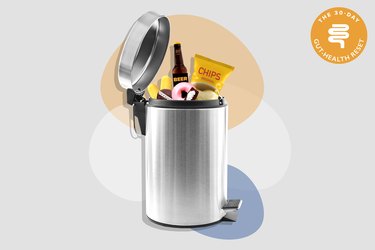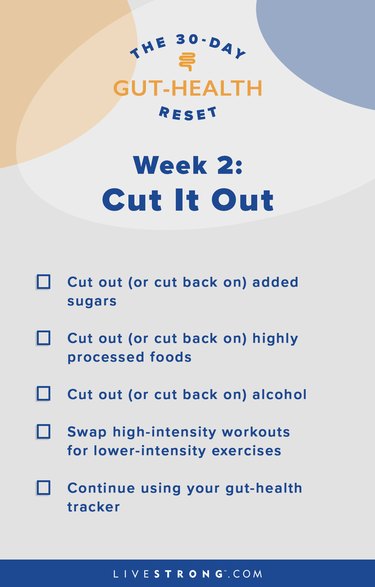
Resetting your gut health is kind of like refreshing your wardrobe: You've got to get rid of some things first before you can add anything new. While you may hesitate to part with that beloved old sweater you haven't worn in years, it'll be worth it to have room for new clothes you feel good in.
The same general concept applies to your digestive health; except when it comes to your gut, the big thing you want to get rid of is inflammation, Vincent Pedre, MD, author of Happy Gut and creator of the 28-Day Happy Gut Cleanse and Happy Gut app, tells LIVESTRONG.com.
"When we have inflammation in the gut, there's probably increased gut permeability," Dr. Pedre says. The gut houses a world of bacteria — some good, some not-so-good — and with a more permeable barrier, unfriendly bacteria can escape, which sends a system-wide signal to the body that it's under attack, he explains. This is called an inflammatory state.
A little bit of inflammation can be effective at fighting off infection or injuries, but you want to avoid being in an always-on inflammatory state. Chronic (or long-lasting) inflammation is linked with a higher risk of serious health conditions, such as diabetes, cancer and heart disease, per the Mayo Clinic.
For Week 2 of our 30-Day Gut-Health Reset with Dr. Pedre, you'll focus on eliminating inflammation triggers. This includes certain foods and drinks as well as high-intensity workouts, which can spark gut distress.
"During this time, we want to take away all things that are going to promote inflammation while we're re-working the internal environment in your body to become more anti-inflammatory," Dr. Pedre says.
Your Goals for Week 2
- Cut out (or cut back on) added sugar
- Cut out (or cut back on) highly processed foods
- Cut out (or cut back on) alcohol
- Swap high-intensity workouts for lower-intensity exercises
- Continue using your gut-health tracker from Week 1
New to the challenge? Click here to get all the details on the 30-day program.
Goal 1: Cut Out (or Cut Back on) Added Sugar
Unsurprisingly, what you eat has a major effect on your gut health. That makes sense: Food lingers in your GI tract for a while — about two to five days, according to the Mayo Clinic. During that period, certain foods may irritate the gut lining or aggravate the immune response, Dr. Pedre says.
One of the biggest offenders is added sugar, whether it's the spoonful you stir into your morning coffee or sweeteners added to foods when they're processed, according to the American Heart Association.
Along with being associated with harmful health conditions such as obesity, eating excessive amounts of sugar can cause the gut to release water and electrolytes, which leads to diarrhea, according to Harvard Health Publishing. Eating sugar may also increase the possibility of chronic inflammation, per the Mayo Clinic.
"Fake" sugars may be an issue, too. Although more research is needed to understand the effects, the artificial sweeteners saccharin and sucralose have been found to change the makeup of gut bacteria, as has stevia, a plant-based sugar-substitute, per a February 2019 review in Advances in Nutrition.
Cut back on added sugar this week with these tips:
- Read the label. Be on the lookout for sugar in all its forms. Check for ingredients that end in "-ose" on the nutrition panel (think: "sucrose"), per the Mayo Clinic. Also look for cane syrup, honey and corn syrup — these are all different names for sugar — and check the nutrition facts for added sugar.
- Avoid soda and keep dessert simple. These are two big sources of sugar, according to the Mayo Clinic. Stick to water when you're thirsty, and try berries instead of sweets like cookies and cake.
- Cut out refined carbs. You'll find them in foods like white bread, pizza and breakfast cereals. Because these foods are low in fiber, your body will digest them quickly, leading to spikes in blood sugar, per the Cleveland Clinic. Those spikes, in turn, lead to inflammation. Other inflammation-causing starchy white foods — white rice, white potatoes — should also be cut, Dr. Pedre says.
Goal 2: Cut Out (or Cut Back on) Highly Processed Foods
Not all processed foods are a no-go. Pre-peeled and chopped butternut squash, for instance, is a massive timesaver and an example of a minimally processed food, according to the Academy of Nutrition and Dietetics.
It's highly processed foods — full of artificial colors, flavors and preservatives, according to the Harvard T.H. Chan School of Public Health — that are linked with poor health and inflammation.
Highly processed foods (also called ultra-processed) often don't need to be cooked at all (think: potato chips, breakfast cereals and packaged cookies), which is just one of the many reasons we tend to eat so much of them. In fact, ultra-processed foods make up nearly 58 percent of Americans' caloric intake, according to a January 2016 BMJ Open analysis.
Getting so many of our calories from ultra-processed foods means we have less room on our plates for gut-friendly picks — and our gut bacteria diversity suffers.
In an August 2017 study in Science, researchers found that the microbiomes of people living in a hunter-gatherer community (read: people who eat mostly whole or minimally processed foods) in Eastern Africa had distinctly more diverse gut bacteria when compared to the microbiomes of people living in industrialized countries.
Follow these tips to reduce the amount of highly processed foods you eat this week:
- Stay away from convenience foods. Avoid frozen dinners, lunch meats and packaged, pre-cooked foods during this reset.
- Check the ingredients. The fewer ingredients, the better. If you don't recognize or can't pronounce an ingredient, it's probably best to skip it.
Goal 3: Cut Out (or Cut Back on) Alcohol
Alcohol is another cause of inflammation in your body, per a 2017 review in Alcohol Research. Plus, while more research in humans is needed, excessive alcohol consumption and long-term consequences of alcohol use (like liver disease) have been linked to a change in the bacteria within your gut, per a December 2019 meta-analysis in Behavioural Brain Research.
It's a no-brainer to eliminate alcohol during a gut reset, Dr. Pedre says. "You don't want to be taxing the liver and making it work overtime," he says.
Tip
When you remove inflammatory foods, you might experience some temporary side effects for a few days, as your body goes into a withdrawal-like state, Dr. Pedre says. Essentially, you might feel worse before you start feeling better. Think of these symptoms as temporary; most people feel much better after their bodies adjust to a healthier diet, he says.
Goal 4: Press Pause on HIIT Workouts
It's not just what you eat that affects your digestive system. Your workouts also play a role.
"Really high-intensity training can increase inflammation in the body," Dr. Pedre says. So, during this gut reset, hold off on HIIT workouts.
But don't give up on exercising entirely: Low-intensity workouts can help keep things moving through your GI tract, which in turn reduces the amount of time potentially harmful pathogens are in contact with your gut lining and at risk of entering the rest of your body, according to a 2015 review in Exercise Immunology Review.
"That's because these lighter movements aid in digestion by contracting, stretching, twisting and relaxing the abdominal muscles, all the while reducing overall stress," says Connecticut-based personal trainer Lauren Seib.
Seib recommends swapping in these lower-intensity workouts to tame digestive distress:
- Strength training: Check out our beginner-friendly guide to getting started with strength training, including a breakdown of the equipment you'll need and recommended exercises to try.
- Barre: Build your dancer power. Here are 10 barre moves you can do at home (no need to go to class).
- Pilates: This workout offers benefits from head to toe. Try these Pilates moves aimed at every body part.
- Walking: This free (and essentially equipment-free) form of exercise offers low-impact cardio and is associated with major health benefits (think: less stress, a longer life expectancy and more). Explore this walking guide for more perks and tips to get started.
- Yoga: If you're new to the practice, try these beginner-friendly yoga moves.
Your Takeaways for Week 2
Eliminating common sources of inflammation is an essential step in our 30-Day Gut-Health Reset. To cut down on inflammation during Week 2, you’ll need to adjust your diet and exercise habits. You may experience some side effects as a result, but take heart: “After you come out the other side, you’re going to feel the best you’ve felt in a long time,” Dr. Pedre says.

Click here for a printer-friendly version of this week's plan!
Is this an emergency? If you are experiencing serious medical symptoms, please see the National Library of Medicine’s list of signs you need emergency medical attention or call 911.